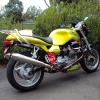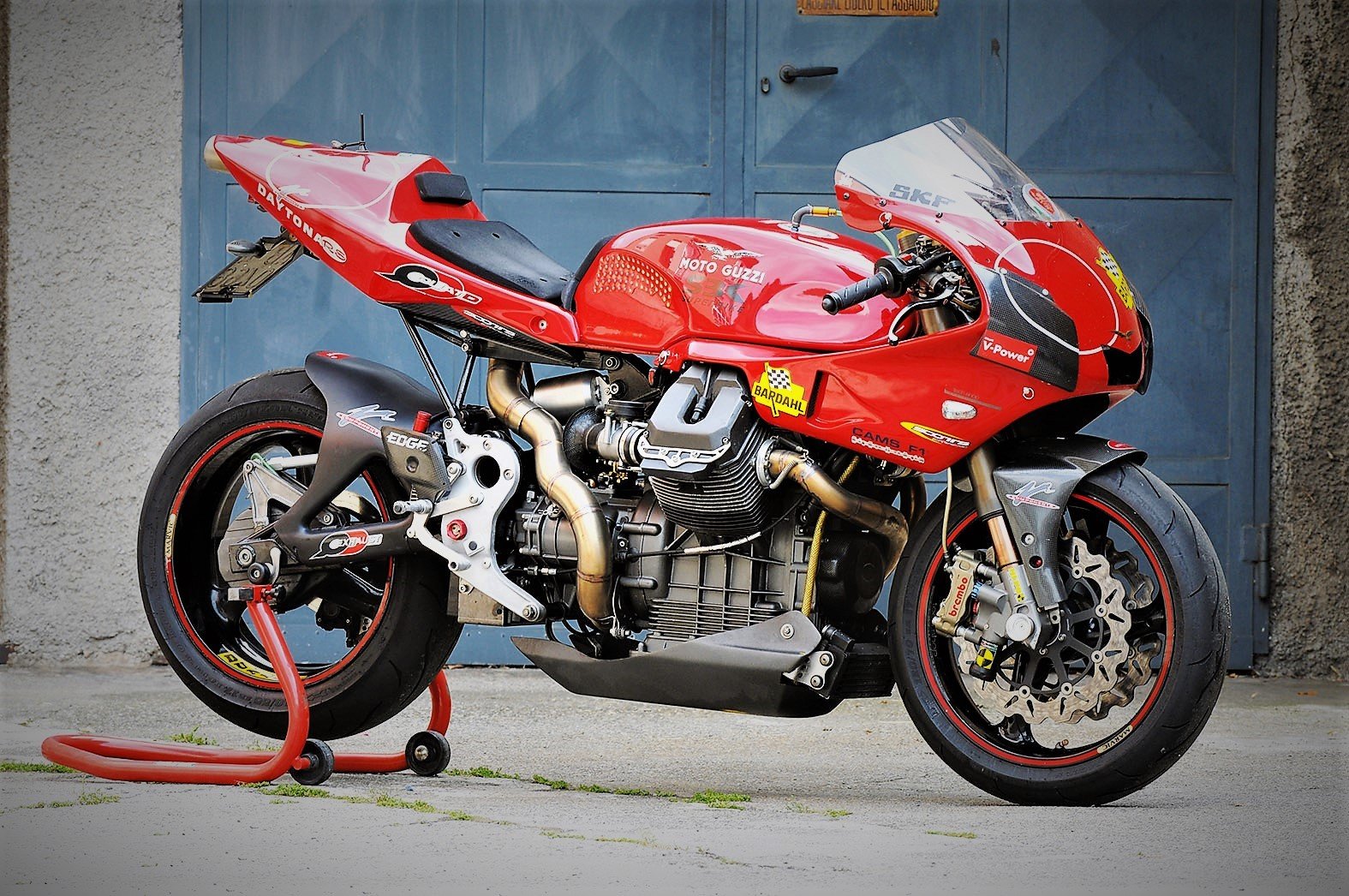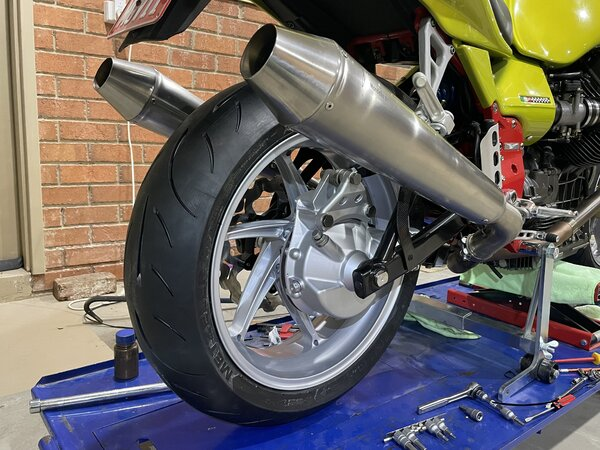-
Posts
5,215 -
Joined
-
Last visited
-
Days Won
268
Content Type
Profiles
Forums
Events
Gallery
Community Map
Everything posted by Lucky Phil
-
I bought these. Metzler Sportec M9 RR 180x55 on the rear and a 120 on the front. I liked the look of them and the tread pattern looks quite sexy and they seemed quite expensive so I figured they must be good. Phil
-
Here's a tip, anything made of rubber buy as spares when you can and treat them with preservative and a clip lock bag and store them away out of the light. Rubber parts are a PITA to replicate or find an alternative to. I have my stash. Phil
-
No it's modified. Had the bell cut off it to fit the pod filter at some point. https://www.officine08.com/p69547_intake-joint-moto-guzzi-1100-sport-i-e-air-filter.html Airbox seal https://www.stein-dinse.com/en/moto-guzzi-rubber-air-filter-short-1100-sport-i-e-corsa/item-1-1127372.html Phil
-
Yea they just have a full circle grommet style seal on the airbox Pete and the trumpet inserts from the airbox and connects to the T/B. The rubber seals are still available I think but the trumpets are hard to find, new anyway. Phil
-
Martin lost the championship because he's a hot head that rides on emotion and bravado and lets his emotions on the track overwhelm him which leads to poor choices. The crash was his fault entirely. I can see an argument for a rider in Marquezes place not engaging with a guy in the title fight at the last round UNLESS that rider has made the total balls up Martin did then it's a straight fight for track position. Bezzecchi is correct Marquez is a protected species and caused his crash. Marquez is a PITA and gets away with way too much in my view. Getting towed around to a decent grid position in Qualifying is a joke. All it means is there is a slower rider without the actual raw speed further up the grid to @#!#$# everyone else around and get in their way come the race. It should go to the old WSB style Qualifying of the one lap shootout where each rider has a warmup lap and then he's got one lap alone on the track to lay down his best time. A true reflection of the riders actual speed and all the yellow flag bullshit is eliminated. BSB has gone back to this system. Then you don't have riders that don't have the actual raw speed without getting a tow in the way at the front of the grid and causing mayhem in the first 1/3 of the race. Marquez knows he hasn't got the raw speed so goes high risk at the start of the races and rolls the dice which often either takes another rider out or at the very least ruins their race by holding them up. Chances of this system being implemented? Zero. Phil
-

Sourcing Allen Screws for Dashboard and Tank Filler
Lucky Phil replied to Kristian's topic in 24/7 V11
I suspect those will be gold anodised alloy screws. I have a ton of them in a box in the workshop. Phil -

I bit the bullet, and spent the bucks!
Lucky Phil replied to LaGrasta's topic in Special place for banter and conversation
Thank god for that. I moved house literally around the corner 18 years ago and tossed out just about everything so I could buy stuff all over again. Phil -

Sourcing Allen Screws for Dashboard and Tank Filler
Lucky Phil replied to Kristian's topic in 24/7 V11
The last place on earth I'd go for those is a Guzzi dealer. The tank cap ones are All M5 but 3 are long and 3 are short decorative ones. Remove the gold ones and you'll find they are the long mount ones at M5X30mm. Buy some Titanium ones off ebay or stainless ones from the hardware store. Phil -

I bit the bullet, and spent the bucks!
Lucky Phil replied to LaGrasta's topic in Special place for banter and conversation
So Mick you took that receipt to Germany when you moved there then! Take your used disposable ear plugs as well Phil -

I bit the bullet, and spent the bucks!
Lucky Phil replied to LaGrasta's topic in Special place for banter and conversation
I moved away from leather jackets a long time ago. To hot for summer and too heavy (as in weight) for the colder months and various other issues like a lack of storage pockets of any practicality. Modern materials have made the classic leather jacket a bit outmoded in every respect but style. On top of that they shrink every year and no longer fit in a few short years -
Brains beats bravado sums it up. Martin gave a perfect example of how not to conduct a race strategy in his situation. Unbelievably he got up blaming Marquez for his off and before that seemed to expect Vinales to just step aside and let him through after he ballsed up his race at turn one. Not to mention his dodgy re-entry to the track just before turn 2. Factory rider class? I don't think so, not yet anyway. Phil
-

ANSWERED Acceleration Enrichment Map-2004 Rosso Corsa
Lucky Phil replied to Rob NZ's topic in Technical Topics
Yes Mick you would need the 15RC ecu to run Lambda. Strange how my bike runs and rides perfectly without Lambda as did the WSB race bike I worked on at one point. On the WSB spec bike one of the mapping mods needed after the usual dyno tuning to Lambda output was for the rider who in various areas needed something other than what was best torque/stio correct to get the throttle feel he needed. Phil -

teslas killing Motorcyclists
Lucky Phil replied to KINDOY2's topic in Special place for banter and conversation
I think Teslas have their place like all EV's just not in my driveway. When owning a car or motorcycle for that matter becomes the same to me as my fridge, washing machine or vacuum cleaner then I'll be in the market for an EV. No automated system to date is perfect and requires human oversight. The 737 NG's I specialised in and did many, many cockpit hours in would at top of descent under autopilot control overspeed the aero six times out of ten unless the pilot intervened. The interface between the autopilot and auto throttle used to get it all wrong and it was never resolved to my knowledge. The Active cruise on my cars is the same, good but not perfect and require monitoring. The issue is the operators, the systems will never be perfect. The worlds been made so safe now all the stupid people aren't naturally culled from the herd anymore and end up taking out the smart people. The future looks promising Phil -

teslas killing Motorcyclists
Lucky Phil replied to KINDOY2's topic in Special place for banter and conversation
It gets worse. This guy Greg is a commercial pilot/Captain that flies for a US airline. All his stuff esp on WW2 aircraft is excellent and very detailed. He has a Car gig on the side and has authored books on Turbocharging cars etc. He's a long way from some sort of conspiracy theorist. Phil -
They do but they can't control what the teams do with them. All heat cycles on the warmers are monitored and logged. A tyre thats been on the warmers and done a cycle is not as good as a fresh tyre with zero heat cycles on it, etc. Slightly too hot setting on the warmer? Tyre is junk. This is how stupid MotoGP is getting,. Becoming like F1. Aero, suspension jacking it's all going down a blind alley just like F1. Phil
-
Thats why I have the tail and stop light elements both wired to come on together for higher load. Pick your poison. Massively lighter weight or an inconvenience in some conditions. I'm never going to be on a bike in cold conditions anyway. Cold to me is sub 15 deg C, lol. Phil
-
Any retail bearing supplier. Just ensure you get either US, German or Japanese made bearings. Any of the major brands. NSK, Timken, Koyo etc. Phil
-
I have an automotive stop and tail light bulb with pigtails soldered to it for testing stuff and removing the flash charge from batteries before testing with a meter etc. If I had this cold weather issue with a Lithium battery I'd just fit my home made tool with either an accessory socket that plugs into the std one on the bike if fitted or onto the remote charging fly leads and let the combined stop and tail light illumination of the bulb warm the battery. My simple tool cois up to the size of the palm of your hand and fits in the front pocket of a pair of jeans. Failing that any simple pair of short leads and a resistor of some kind would work. Plug in a heated vest for a while might do it as well. Phil
-
Yea I saw that but didn't realise you could buy online. Phil
-
Ok so I will try a Lithium battery. I've used one in my Suzuki track bike but that's a Japanese charging system not a Luigi system. Shorai batteries are a bit of an issue to get here though. Phil
-
I feel somewhat better now knowing that. I weighed a V11 bare head fitted with valves and springs and the inlet manifold and rubber and a bare Daytona head without valves rockers etc but with the rocker support and a cam in it. I doubt a Daytona head would weigh more than 2 Kg over the V11 head complete. So that's 4 KG plus cam drive pulleys and belts etc. So I think the engine would be in that +5 to 6kg more range. The cams alone in the Daytona engine weigh 865 Grams each and it still has a jackshaft in place of the original Camshaft. As Mick said a Lithium battery would drop probably 5 KG. Is there any experience with the LiPo batteries in the V11. Does the charging system treat them OK? I'm sure some here have tried them in the past. Phil
-
I think your maths is ok docc. Maybe southern hemisphere weight is different to northern. Phil
-
Well my bike also has the Stucchi crossover and the Agostini mufflers for probably a weight saving of 6Kg. As an estimate I'd say the Daytona engine weighs maybe 6-8Kg more than the V11 engine. Lighter rods, crank but heavier heads inc cams etc, and valve drive gear. So I've dumped around 16Kg added about 6-8 and somehow ended up with a bike heavier than a std V11 Sport. Phil
-
No just the tyre and wheel combinations but the tyres were 170 and 180 so not much use there. The rear shock is better but probably heavier although it has an alloy body but preload adjuster assembly will weigh a bit. I'd be interested to know what a std V11 Sport weighs in at. It would be above what Guzzi advertised at the time I'm sure now. It's also got the later 43mm forks and much lighter 25mm hollow front axle. How's it handle? Better than before by a decent margin. Phil





